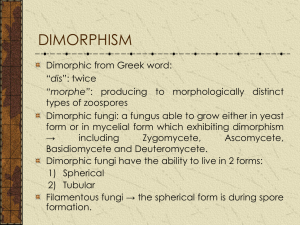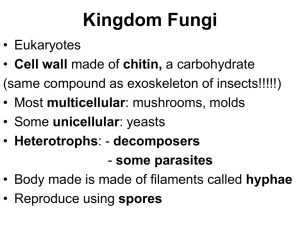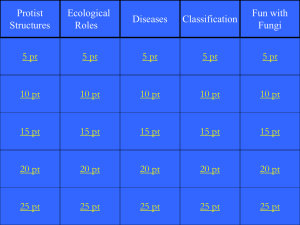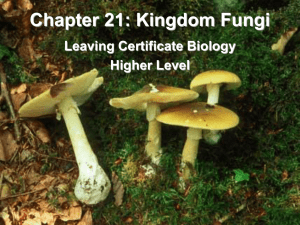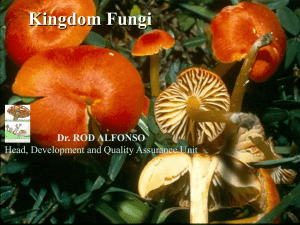Introduction to Mycology
advertisement
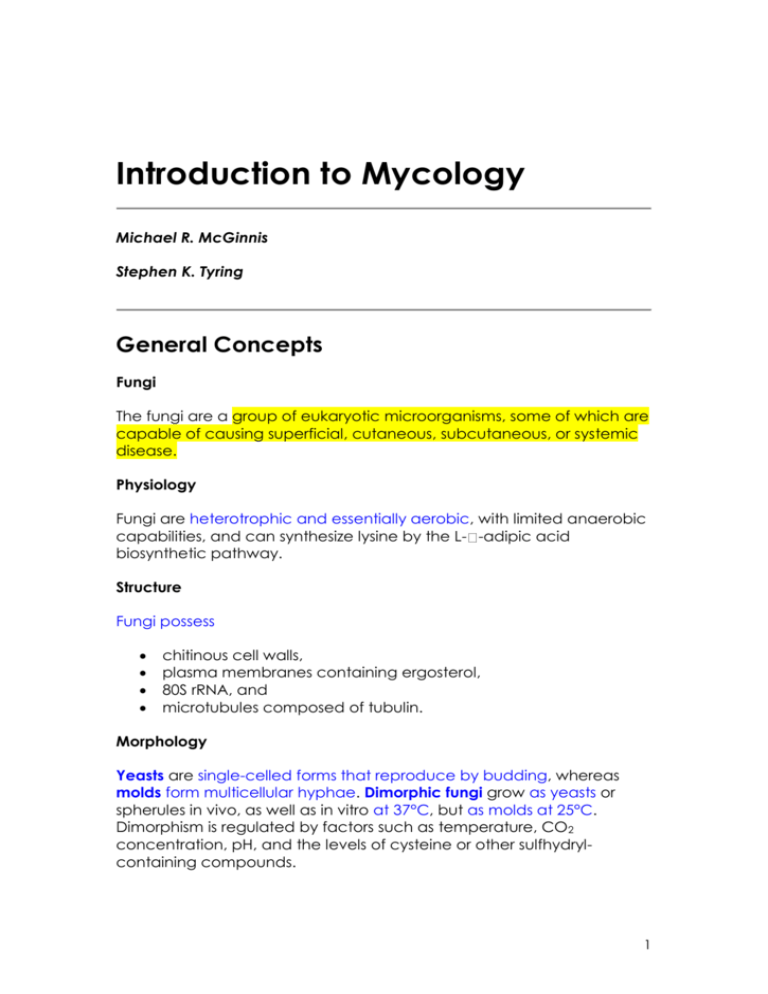
Kāpēc ke Mārtiņa krājumiem Introduction to Mycology Michael R. McGinnis Stephen K. Tyring General Concepts Fungi The fungi are a group of eukaryotic microorganisms, some of which are capable of causing superficial, cutaneous, subcutaneous, or systemic disease. Physiology Fungi are heterotrophic and essentially aerobic, with limited anaerobic capabilities, and can synthesize lysine by the L- -adipic acid biosynthetic pathway. Structure Fungi possess chitinous cell walls, plasma membranes containing ergosterol, 80S rRNA, and microtubules composed of tubulin. Morphology Yeasts are single-celled forms that reproduce by budding, whereas molds form multicellular hyphae. Dimorphic fungi grow as yeasts or spherules in vivo, as well as in vitro at 37°C, but as molds at 25°C. Dimorphism is regulated by factors such as temperature, CO2 concentration, pH, and the levels of cysteine or other sulfhydrylcontaining compounds. 1 Propagules Conidia are asexual propagules (reproductive units) formed in various manners. Spores may be either asexual or sexual in origin. Asexual spores are produced in sac-like cells called sporangia and are called sporangiospores. Sexual spores include ascospores, basidiospores, oospores, and zygospores, which are used to determine phylogenetic relationships. Classification Asexual structures are referred to as anamorphs; sexual structures are known as teleomorphs; and the whole fungus is known as the holomorph. Two independent, coexisting classification systems, one based on anamorphs and the other on teleomorphs, are used to classify fungi. INTRODUCTION Fungi are eukaryotic microorganisms. Fungi can occur as yeasts, molds, or as a combination of both forms. Some fungi are capable of causing superficial, cutaneous, subcutaneous, systemic or allergic diseases. Yeasts are microscopic fungi consisting of solitary cells that reproduce by budding. Molds, in contrast, occur in long filaments known as hyphae, which grow by apical extension. Hyphae can be sparsely septate to regularly septate and possess a variable number of nuclei. Regardless of their shape or size, fungi are all heterotrophic and digest their food externally by releasing hydrolytic enzymes into their immediate surroundings (absorptive nutrition). Other characteristics of fungi are the ability to synthesize lysine by the L- -adipic acid biosynthetic pathway and possession of a chitinous cell wall, plasma membranes containing the sterol ergosterol, 80S rRNA, and microtubules composed of tubulin. 2 Physiology Fungi can use a number of different carbon sources to meet their carbon needs for the synthesis of carbohydrates, lipids, nucleic acids, and proteins. Oxidation of sugars, alcohols, proteins, lipids, and polysaccharides provides them with a source of energy. Differences in their ability to utilize different carbon sources, such as simple sugars, sugar acids, and sugar alcohols, are used, along with morphology, to differentiate the various yeasts. Fungi require a source of nitrogen for synthesis of amino acids for proteins, purines and pyrimidines for nucleic acids, glucosamine for chitin, and various vitamins. Depending on the fungus, nitrogen may be obtained in the form of nitrate, nitrite, ammonium, or organic nitrogen; no fungus can fix nitrogen. Most fungi use nitrate, which is reduced first to nitrite (with the aid of nitrate reductase) and then to ammonia. Nonfungal organisms, including bacteria, synthesize the amino acid lysine by the meso-diaminopimelic acid pathway (DAP pathway), whereas fungi synthesize lysine by only the L- -adipic acid pathway (AAA pathway). Use of the DAP pathway is one of the reasons microorganisms previously considered to be fungi, such as the myxomycetes, oomycetes, and hyphochytrids, are no longer classified as fungi. The DAP and AAA biosynthetic pathways for lysine synthesis represent dichotomous evolution. Structure Cell Wall The rigid cell wall of fungi (see ch. 73, Fig. 2A) is a stratified structure consisting of chitinous microfibrils embedded in a matrix of small polysaccharides, proteins, lipids, inorganic salts, and pigments that provides skeletal support and shape to the enclosed protoplast. Chitin is a ( -4)-linked polymer of N-acetyl-D-glucosamine (GlcNAc). It is produced in the cytosol by the transfer of GlcNAc from uridine diphosphate GlcNAc into chains of chitin by chitin synthetase, which is located in the cytosol in organelles called chitosomes. The chitin microfibrils are transported to the plasmalemma and subsequently integrated into the new cell wall. The major polysaccharides of the cell wall matrix consist of noncellulosic glucans such as glycogen-like compounds, mannans (polymers of mannose), chitosan (polymers of glucosamine), and galactans (polymers of galactose). Small amounts of fucose, rhamnose, xylose, and uronic acids may be present. Glucan refers to a large group of D-glucose polymers having glycosidic bonds. Of these, the most common - 3 -3)-6)-linked glucosyl units with various proportions of 1-3 and 1glucans are apparently amorphous in the cell wall. In Paracoccidioides brasiliensis, the hyphal cell wall consists of a single, 80- to 150-nm layer -glucan. In contrast, the 200- to 600-nm-thick yeast cell wall has three layers. The inner surface is chitinous, containing -glucan, and the outer l -glucan. It has been -3)-glucan occurs in a microfibrillar form in P brasiliensis and Histoplasma capsulatum. Many fungi, especially the yeasts, have soluble peptidomannans as a component of their outer cell wall in a -glucans. Mannans, galactomannans, and, less frequently, rhamnomannans are responsible for the immunologic response to the medically important yeasts and molds. Mannans are polymers of mannose or heteroglucans -D-mannan backbones. Structurally, mannan consists of an inner core, outer chain, and base-labile oligomannosides. The outer-chain region determines its antigenic specificity. Determination of mannan concentrations in serum from patients with disseminated candidiasis has proven a useful diagnostic technique. Cryptococcus neoformans produces a capsular polysaccharide composed of at least three distinct polymers: glucuronoxylomannan, galactoxylomannan, and mannoprotein. On the basis of the proportion of xylose and glucuronic acid residues, the degree to which mannose has side-chain substituents, and the percentage of O-acetyl attachments of the capsular polysaccharides, isolates of C neoformans can be separated into four antigenic groups designated A, B, C, and D. The capsule is antiphagocytic, serves as a virulence factor, persists in body fluids, and allows the yeast to avoid detection by the host immune system. In addition to chitin, glucan, and mannan, cell walls may contain lipid, protein, chitosan, acid phosphatase, -amylase, protease, melanin, and inorganic ions such as phosphorus, calcium, and magnesium. The outer cell wall of dermatophytes contains glycopeptides that may evoke both immediate and delayed cutaneous hypersensitivity. In the yeast Candida albicans, for example, the cell wall contains approximately 30 to 60 percent glucan, 25 to 50 percent mannan (mannoprotein), 1 to 2 percent chitin (located primarily at the bud scars in the parent yeast cell wall), 2 to 14 percent lipid, and 5 to 15 percent protein. The proportions of these components vary greatly from fungus to fungus. Table-M1 summarizes the relationship between cell wall composition and taxonomic grouping of the fungi. 4 Plasma Membrane Fungal plasma membranes are similar to mammalian plasma membranes, differing in having the nonpolar sterol ergosterol, rather than cholesterol, as the principal sterol. The plasma membrane regulates the passage of materials into and out of the cell by being selectively permeable. Membrane sterols provide structure, modulation of membrane fluidity, and possibly control of some physiologic events. The plasma membrane contains primarily lipids and protein, along with small quantities of carbohydrates. The major lipids are the amphipathic phospholipids and sphingolipids that form the lipid bilayer. The hydrophilic heads are toward the surface, and the hydrophobic tails are buried in the interior of the membrane. Proteins are interspersed in the bilayer, with peripheral proteins being weakly bound to the membrane. In contrast, integral proteins are tightly bound. The lipoprotein structure of the membrane provides an effective barrier to many types of molecules. Molecules cross the membrane by either diffusion or active transport. The site of interaction for most antifungal agents is the ergosterol in the membrane or its biosynthetic pathway. Polyene antifungal agents such as amphotericin B bind to ergosterol to form complexes that permit the rapid leakage of the cellular potassium, other ions, and small molecules. The loss of potassium results in the inhibition of glycolysis and respiration. Several antifungal agents interfere with ergosterol synthesis. The first step in the synthesis of both ergosterol and cholesterol is demethylation of lanosterol. The necessary enzymes are associated with fungal microsomes, which contain an electron transport system analogous to the one in liver microsomes. Cytochrome P450 catalyzes the 1 4- demethylation of lanosterol, an essential step in the synthesis of 5 ergosterol. The imidazole and triazole antifungal agents interfere with cytochrome P450-dependent 1 4- -demethylase, which inhibits the formation of ergosterol. This results in plasma membrane permeability changes and inhibition of growth. Ergosterol may also be involved in regulating chitin synthesis. Inhibition of ergosterol synthesis by antifungal agents can result in a general activation of chitin synthetase zymogen, leading to excessive chitin production and abnormal growth. Microtubules Fungi possess microtubules composed of the protein tubulin. This protein consists of a dimer composed of two protein subunits. Microtubules are long, hollow cylinders approximately 25 nm in diameter that occur in the cytoplasm as a component of larger structures. These structures are involved in the movement of organelles, chromosomes, nuclei, and Golgi vesicles containing cell wall precursors. Microtubules are the principal components of the spindle fibers, which assist in the movement of chromosomes during mitosis and meiosis. When cells are exposed to antimicrotubule agents, the movement of nuclei, mitochondria, vacuoles, and apical vesicles is disrupted. Griseofulvin, which is used to treat dermatophyte infections, binds with microtubule-associated proteins involved in the assembly of the tubulin dimers. By interfering with tubulin polymerization, griseofulvin stops mitosis at metaphase. The destruction of cytoplasmic microtubules interferes with the transport of secretory materials to the cell periphery, which may inhibit cell wall synthesis. The fungal nucleus is bounded by a double nuclear envelope and contains chromatin and a nucleolus. Fungal nuclei are variable in size, shape, and number. The DNA and associated proteins occur as long filaments of chromatin, which condenses during nuclear division. The number of chromosomes varies with the particular fungus. Within the cell, 80 to 99 percent of the genetic material occurs in chromosomes as chromatin, and approximately 1 to 20 percent in the mitochondria. In some isolates of Saccharomyces cerevisiae, up to 5 percent of their DNA can be found in nuclear plasmids. When the DNA helix unwinds, one strand serves as the template for the synthesis of rRNA, tRNA, and mRNA. mRNA passes into the cytoplasm and attaches to one of the ribosomes, which are complexes of RNA and protein that serve as sites for the synthesis of protein. 6 Morphology Yeasts Yeasts are fungi that grow as solitary cells that reproduce by budding (see ch. 73 Fig. 4 and 5). Yeast taxa are distinguished on the basis of the presence or absence of capsules, the size and shape of the yeast cells, the mechanism of daughter cell formation (conidiogenesis), the formation of pseudohyphae and true hyphae, and the presence of sexual spores, in conjunction with physiologic data. Morphology is used primarily to distinguish yeasts at the genus level, whereas the ability to assimilate and ferment various carbon sources and to utilize nitrate as a source of nitrogen are used in conjunction with morphology to identify species. Yeasts such as C albicans and Cryptococcus neoformans produce budded cells known as blastoconidia. The formation of blastoconidia involves three basic steps: bud emergence, bud growth, and conidium separation. During bud emergence, the outer cell wall of the parent cell thins. Concurrently, new inner cell wall material and plasma membrane are synthesized at the site where new growth is occurring. New cell wall material is formed locally by activation of the polysaccharide synthetase zymogen. The process of bud emergence is regulated by the synthesis of these cellular components as well as by the turgor pressure in the parent cell. Mitosis occurs, as the bud grows, and both the developing conidium and the parent cell will contain a single nucleus. A ring of chitin forms between the developing blastoconidium and its parent yeast cell. This ring grows in to form a septum. Separation of the two cells leaves a bud scar on the parent cell wall. The bud scar contains much more chitin than does the rest of the parent cell wall. When the production of blastoconidia continues without separation of the conidia from each other, a pseudohypha, consisting of a filament of attached blastoconidia, is formed. In addition to budding yeast cells and pseudohyphae, yeasts such as C albicans may form true hyphae. Candida albicans Candida albicans may form a budding yeast, pseudohyphae, germ tubes, true hyphae, and chlamydospores. A number of investigators are interested in germ tube formation because it represents a transition between a yeast and a mold. Generally, either low temperature or pH favors the development of a budding yeast. Other substances such as biotin, cysteine, serum transferrin, and zinc stimulate dimorphism in this yeast. 7 Approximately 20 percent of the C albicans yeast cell wall is mannan, whereas the mycelial cell wall contains a substantially smaller amount of this sugar. Candida albicans has three serotypes, designated A, B, and C. These are distinguished from each other on the basis of their mannans. The antigenic determinant for serotype A is its mannoheptaose side chain. In serotype B, it is the mannohexaose side chain. Serotype B tends to be more resistant to 5-fluorocytosine than is serotype A. Glucans with ( -3)-6)-linked groups compose about 50 to 70 percent of the yeast cell wall. It has been suggested that these glucans may impede the access of amphotericin B to the plasma membrane. Molds Molds are characterized by the development of hyphae (see ch. 73, Fig. 3), which result in the colony characteristics seen in the laboratory. Hyphae elongate by a process known as apical elongation, which requires a careful balance between cell wall lysis and new cell wall synthesis. Because molds are often differentiated on the basis of conidiogenesis, structures such as conidiophores and conidiogenous cells must be carefully evaluated. Some molds produce special sac-like cells called sporangia, the entire protoplasm of which becomes cleaved into spores called sporangiospores. Sporangia are typically formed on special hyphae called sporangiophores. Dimorphism A number of medically important fungi express themselves phenotypically as two different morphologic forms, which correlate with the saprophytic and parasitic modes of growth. Such fungi are called dimorphic fungi. Some researchers restrict the term to pathogens that grow as a mold at room temperature in the laboratory and as a budding yeast or as spherules either in tissue or at 37°C. In contrast, others use dimorphic for any fungus that can exist as two different phenotypes, regardless of whether it is pathogenic. We prefer to use the term "dimorphic" to describe fungi that typically grow as a mold in vitro and as either yeast cells or spherules in vivo (Table-M2). Examples of medically important dimorphic fungi include Blastomyces dermatitidis (hyphae and yeast cells) and Coccidioides immitis (hyphae and spherules). 8 9 10 A number of external factors contribute to the expression of dimorphism. Increased incubation temperature is the single most important factor. Increased carbon dioxide concentration, which probably affects the oxidation-reduction potential, enhances the conversion of the mycelial form to the tissue form in C immitis and Sporothrix schenckii. pH affects the development of the yeast form in some fungi, and cysteine or other sulfhydryl-containing compounds affects it in others. Some fungi require a combination of these factors to induced dimorphism. Blastomyces dermatitidis The conversion of the mycelial form of Blastomyces dermatitidis to the large, globose, thick-walled, broadly based budding yeast form requires only increased temperature. Hyphal cells enlarge and undergo a series of changes resulting in the transformation of these cells into yeast cells. The cells enlarge, separate, and then begin to reproduce by budding. The yeast cell wall contains approximately 95 -3)-3)-glucan. In contrast, the 11 -3)-glucan and 40 percent -3)-glucan . Coccidioides immitis Coccidioides immitis is a unique dimorphic fungus because it produces spherules containing endospores in tissue, and hyphae at 25°C. Increased temperature, nutrition, and increased carbon dioxide are important for the production of sporulating spherules. A uninucleate arthroconidium begins to swell and undergo mitosis to produce additional nuclei. Once mitosis stops, initiation of spherule septation occurs. The spherule is segmented into peripheral compartments with a persistent central cavity. Uninucleate endospores occurring in packets enclosed by a thin membranous layer differentiate within the compartments. As the endospores enlarge and mature, the wall of the spherule ruptures to release the endospores (Fig. M1 ) . Pairs of closely appressed endospores that have not completely separated from each other may resemble the budding yeast cells of B dermatitidis. FIGURE-M1 Development of the spherule of Coccidioides immitis from an arthroconidium. (From Cole GT, Kendrick B: Biology of Conidial Fungi. Academic Press, San Diego, 1981, with permission.) 12 Histoplasma capsulatum Dimorphism in Histoplasma capsulatum involves three stages. In the first stage, induced by an increase in temperature, respiration ceases and the level of cytochromes decreases. During the second stage of the mycelial-to-yeast conversion, cysteine or other sulfhydryl-containing compounds are required. Shunt pathways are initiated that restore the appropriate cytochrome levels, which supply the needed ATP. Cysteine is also required for the yeast form to grow. The final stage is characterized by normal cytochrome levels and respiration as the yeast grows and reproduces. The conversion of terminal or intercalary hyphal cells to a yeast form requires 3 to 14 days. In tissue, H capsulatum proliferates within giant cells. Yeast cells of H capsulatum have been divided into two chemotypes. Chemotype 1, which correlates with serotypes 1, 2, and 3, contains large amounts of (b1-3)-glucans and small amounts of chitin. -3)-3)-glucan, and more chitin. Chemotype 2 correlates with serotypes 1 and 4. It is difficult to assess the importance of the chemotypes, because only a few isolates have been studied. Paracoccidioides brasiliensis A great deal of work has been done with the mycelial-to-yeast conversion of Paracoccidioides brasiliensis. In tissue the yeast is characterized by multiple budding. Series of smaller yeast daughter cells attached by narrow tubular necks are formed around a large central cell. Hyphal cells first swell and then separate from each other. The separated cells begin to bud, resulting in a yeast growth. As with H capsulatum, growth stops briefly as a result of increased temperature. At -3)-glucan decreases and the hyphal cell wall -3)-glucans are formed as a layer on the outer cell wall surface of the yeast cells. The yeast cell wall of P brasiliensis has three layers and is approximately -3)-3)-glucans. In contrast, the mycelial cell wall consists of one layer that is 80 to 150 nm thick, composed of chitin a -3)-3)-glucan of P brasiliensis is an important virulence factor. Only the yeast form has this -linked glucan is absent, pathogenicity is -glucan results in increased virulence. 13 Penicillium marneffei Penicillium marneffei is a dimorphic fungus that is becoming extremely important as a pathogen in AIDS patients living in Southeast Asia. The fungus has been recovered from soil associated with plants such as bamboo. In tissue, the fungus forms yeast cells that divide by fission. Like H. capsulatum, they proliferate within giant cells. Sporothrix schenckii The last dimorphic fungus to be considered is Sporothrix schenckii. In this species, mycelial-to-yeast conversion is enhanced by increased carbon dioxide, increased temperature, and nutrition. The yeast form readily appears at 37°C and 5 percent carbon dioxide. It has been suggested that some product of carbon dioxide fixation may be required for development of the yeast form. Unlike the other dimorphic fungi capable of producing a yeast form, S schenckii initially produces yeast cells by direct budding from hyphae. In addition, the cell wall chemistry of the hyphal and yeast forms is similar. Glucans having ( 3)-4)-6)-linkages are present in addition to chitin. Rhamnomannan is the major antigenic determinant. The yeast cell wall is thought to contain more peptidorhamnomannan than the hyphal cell wall. Propagules (Spores and Conidia) Spores can be produced either asexually or sexually. Asexual spores are always formed in a sporangium following mitosis and cytoplasmic cleavage. The number of sporangiospores and their arrangement in the sporangium are used to differentiate the various zygomycetes. Sexual spores (Table-3) occur following meiosis. Ascospores (see Ch. 73, Fig. 5A) are formed in a saclike cell (called an ascus) by free-cell formation, basidiospores form on basidia (see Ch. 73, Fig. 5B), and zygospores form within zygosporangia. Oospores are sexual spores that are produced by one group of fungi that will not be considered because they are medically unimportant. Sexual spores are rarely seen in clinical isolates because most fungi are heterothallic (i.e., sexually self-sterile). Typically, only one of the two mating types is isolated from a particular clinical specimen. When homothallic isolates are recovered in the clinical laboratory, they often produce sexual spores because they are sexually self-fertile. Conidia are always asexual in origin (see Ch. 73, Fig. 6) and develop in any manner that does not involve cytoplasmic cleavage. The ontogeny of conidia (conidiogenesis) and their arrangement, color, and septation are used to differentiate the various genera of molds. Some fungi have melanin in the cell wall of the conidia, the hyphae, or 14 both. Such fungi are considered to be dematiaceous. Many of the name changes that have been recently proposed reflect a better understanding of conidiogenesis. Classification In mycology, fungi are classified on the basis of their ability to reproduce sexually, asexually, or by a combination of both (Table-M3). Asexual reproductive structures, which are referred to as anamorphs, are the basis for one of the sets of criteria. Because the criteria are based upon asexual morphologic forms, this system does not reflect phylogenetic relationships. It exists so that we can communicate in a simple and consistent manner by using names based upon similar morphologic structures. The second set of criteria is based upon sexual reproductive structures, which are referred to as teleomorphs. Ascospores, basidiospores, oospores, and zygospores, as well as any specialized structures associated with their development, are the basis of the second set of criteria. These criteria reflect phylogenetic relationships because they are based upon structures that form following meiosis. The term holomorph is used to describe the whole fungus, which consists of its teleomorph and anamorphs. For example, the dimorphic fungus Blastomyces dermatitidis produces two anamorphs, one consisting of hyphae and one-celled conidia at 25°C and one consisting of budding yeast cells at 37°C. The name B dermatitidis summarizes these two anamorphs. When two sexually compatible isolates of B dermatitidis are mated under the appropriate conditions, a sexual fruiting body, called a gymnothecium, containing ascospores will develop. The name that is used for this sexual form or teleomorph is Ajellomyces dermatitidis. When one wishes to refer to the whole fungus, the name for the teleomorph is used because it reflects phylogenetic relationships. It is important to note that the name B dermatitidis can be used whenever one wishes to refer to the hyphal or yeast forms of this fungus. 15 REFERENCES Bartnicki-Garcia S: Cell wall chemistry, morphogenesis, and taxonomy of fungi. Ann Rev Microbiol 22:87, 1968 Cole GT, Samson RA: Patterns of Development in Conidial Fungi. Pittman, London, 1979 Fleet GH: Composition and structure of yeast cell walls. p. 24. In McGinnis MR (ed): Current Topics in Medical Mycology. Vol. 1. SpringerVerlag, New York, 1985 Gow NAR, Gadd GM (ed): The Growing Fungus, Chapman and Hall, London, 1994 Kwon-chung KJ, Bennett JE: Medical Mycology. Lea and Febiger, Philadelphia, 1992 McGinnis MR: Laboratory Handbook of Medical Mycology. Academic Press, San Diego, 1980 McGinnis MR, Borgers M (eds): Current Topics in Medical Mycology. Springer-Verlag, New York, 1989 Murphy JW, Friedman H, Bendinelli M (eds): Fungal Infections and Immune Responses. Plenum Press, New York, 1993 San-Blas G: Paracoccidioides brasiliensis: cell wall glucans, pathogenicity, and dimorphism. p. 235. In McGinnis MR (ed): Current Topics in Medical Mycology. Vol.1. Springer-Verlag, New York, 1985 Shepherd MG: Morphogenetic transformation of fungi. p.278. In McGinnis MR (ed): Current Topics in Medical Mycology. Vol. 2. SpringerVerlag, New York, 1988 Vanden Bossche H, Odds FC, Kerridge D (eds): Dimorphic Fungi in Biology and Medicine. Plenum Press, New York, 1993 Yoshida Y: Cytochrome P-450 of fungi: primary target for azole antifungal agents. p. 388. In McGinnis MR (ed): Current Topics in Medical Mycology. Vol. 2. Springer-Verlag, New York, 1988 16



